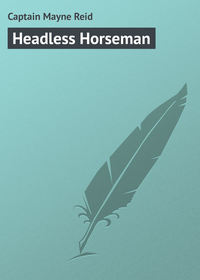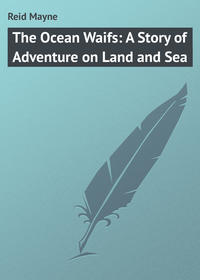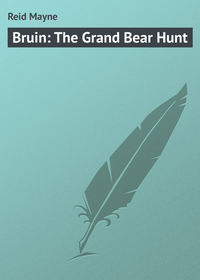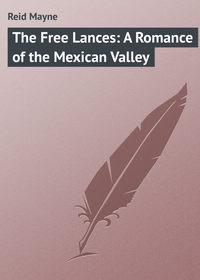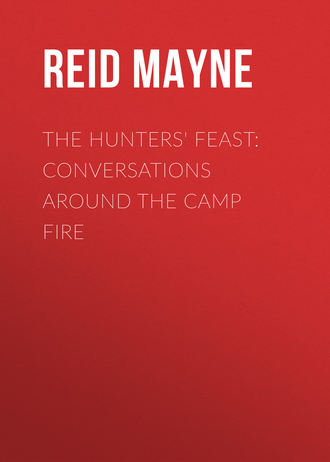 полная версия
полная версияThe Hunters' Feast: Conversations Around the Camp Fire
The parts most esteemed are the tongue, the “hump-ribs” (the long spinous processes of the first dorsal vertebra), and the marrow of the shank bones. “Boudins” (part of the intestines) are also favourite “tit-bits” among the Indians and trappers.
The tongues, when dried, are really superior to those of common beeves, and, indeed, the same may be said of the other parts, but there is a better and worse in buffalo-beef, according to the age and sex of the animal. “Fat cow” is a term for the super-excellent, and by “poor bull,” or “old bull,” is meant a very unpalatable article, only to be eaten by the hunter in times of necessity.
The range of the buffalo is extensive, though not as it once was. It is gradually being restricted by hunter-pressure, and the encroachments of civilisation. It now consists of a longitudinal strip, of which the western boundary may be considered the Rocky Mountains, and the eastern the Mississippi River, though it is only near the head waters of the latter that the range of this animal extends so far east. Below the mouth of the Missouri no buffalo are found near the Mississippi, nor within two hundred miles of it – not, in fact, until you have cleared the forests that fringe this stream, and penetrated a good distance into the prairie tract. At one period, however, they roamed as far to the east as the Chain of the Alleghanies.
In Texas, the buffalo yet extends its migrations to the head waters of the Brazos and Colorado, but it is not a Mexican animal. Following the Rocky Mountains from the great bend of the Rio Grande, northward, we find no buffalo west of them until we reach the higher latitudes near the sources of the Saskatchewan. There they have crossed the mountains, and are now to be met with in some of the plains that lie on the other side. This, however, is a late migration, occasioned by hunter-pressure upon the eastern slope. The same has been observed at different periods, at other points in the Rocky Mountain chain, where the buffalo had made a temporary lodgment on the Pacific side of the mountains, but where they are now entirely extinct. It is known, from the traditional history of the tribes on the west side, that the buffalo was only a newcomer among them, and was not indigenous to that division of the Continent.
Following the buffaloes north, we find their range co-terminous with the prairies. The latter end in an angle between the Peace River and the great Slave Lake, and beyond this the buffalo does not run. There is a point, however, across an arm of the Slave Lake where buffalo are found. It is called Slave Point, and although contiguous to the primitive rocks of the “Barren Grounds” it is of a similar geology (stratified limestone) with the buffalo prairies to the west. This, to the geologist, is an interesting fact.
From the Slave Lake, a line drawn to the head waters of the Mississippi, and passing through Lake Winnipeg, will shut in the buffalo country along the north-east. They are still found in large bands upon the western shores of Winnipeg, on the plains of the Saskatchewan and the Red River of the north. In fact, buffalo-hunting is one of the chief employments of the inhabitants of that half-Indian colony known as the “Red River Settlements.”
One of the most singular facts in relation to the buffalo is their enormous numbers. Nothing but the vast extent of their pasturage could have sustained such droves as have from time to time been seen. Thousands frequently feed together, and the plain for miles is often covered with a continuous drove. Sometimes they are seen strung out into a long column, passing from place to place, and roads exist made by them that resemble great highways. Sometimes these roads, worn by the rains, form great hollows that traverse the level plain, and they often guide the thirsty traveller in the direction of water.
Another curious fact about the buffalo is their habit of wallowing. The cause of this is not well-ascertained. It may be that they are prompted to it, as swine are, partly to cool their blood by bringing their bodies in contact with the colder earth, and partly to scratch themselves as other cattle do, and free their skins from the annoying insects and parasites that prey upon them. It must be remembered that in their pasturage no trees or “rubbing posts” are to be found, and in the absence of these they are compelled to resort to wallowing. They fling themselves upon their sides, and using their hunch and shoulder as a pivot, spin round and round for hours at a time. In this rotatory motion they aid themselves by using the legs freely. The earth becomes hollowed out and worn into a circular basin, often of considerable depth, and this is known as a “buffalo wallow.” Such curious circular concavities are seen throughout the prairies where these animals range; sometimes grown over with grass, sometimes freshly hollowed out, and not unfrequently containing water, with which the traveller assuages his thirst, and so, too, the buffalo themselves. This has led to the fanciful idea of the early explorers that there existed on the American Continent an animal who dug its own wells!
The buffaloes make extensive migrations, going in large “gangs.” These are not periodical, and are only partially influenced by climate. They are not regular either in their direction. Sometimes the gangs will be seen straying southward, at other times to the north, east, or west.
The search of food or water seems partially to regulate these movements, as with the passenger-pigeon, and some other migratory creatures.
At such times the buffaloes move forward in an impetuous march which nothing seems to interrupt. Ravines are passed, and waterless plains traversed, and rivers crossed without hesitation. In many cases broad streams, with steep or marshy banks, are attempted, and thousands either perish in the waters or become mired in the swamp, and cannot escape, but die the most terrible of deaths. Then is the feast of the eagles, the vultures, and the wolves. Sometimes, too, the feast of the hunter; for when the Indians discover a gang of buffaloes in a difficulty of this kind, the slaughter is immense.
Hunting the buffalo is, among the Indian tribes, a profession rather than a sport. Those who practise it in the latter sense are few indeed, as, to enjoy it, it is necessary to do as we had done, make a journey of several hundred miles, and risk our scalps, with no inconsiderable chance of losing them. For these reasons few amateur-hunters ever trouble the buffalo.
The true professional hunters – the white trappers and Indians – pursue these animals almost incessantly, and thin their numbers with lance, rifle, and arrow.
Buffalo-hunting is not all sport without peril. The hunter frequently risks his life; and numerous have been the fatal results of encounters with these animals. The bulls, when wounded, cannot be approached, even on horseback, without considerable risk, while a dismounted hunter has but slight chance of escaping.
The buffalo runs with a gait apparently heavy and lumbering – first heaving to one side, then to the other, like a ship at sea; but this gait, although not equal in speed to that of a horse, is far too fast for a man on foot, and the swiftest runner, unless favoured by a tree or some other object, will be surely overtaken, and either gored to death by the animal’s horns, or pounded to a jelly under its heavy hoofs. Instances of the kind are far from being rare, and could amateur-hunters only get at the buffalo, such occurrences would be fearfully common. An incident illustrative of these remarks is told by the traveller and naturalist Richardson, and may therefore be safely regarded as a fact.
“While I resided at Charlton House, an incident of this kind occurred. Mr Finnan McDonald, one of the Hudson’s Bay Company’s clerks, was descending the Saskatchewan in a boat, and one evening, having pitched his tent for the night, he went out in the dusk to look for game.
“It had become nearly dark when he fired at a bison bull, which was galloping over a small eminence; and as he was hastening forward to see if the shot had taken effect, the wounded beast made a rush at him. He had the presence of mind to seize the animal by the long hair on his forehead, as it struck him on the side with its horn, and being a remarkably tall and powerful man, a struggle ensued, which continued until his wrist was severely sprained, and his arm was rendered powerless; he then fell, and after receiving two or three blows, became senseless.
“Shortly after, he was found by his companions lying bathed in blood, being gored in several places; and the bison was couched beside him, apparently waiting to renew the attack, had he shown any signs of life. Mr McDonald recovered from the immediate effects of the injuries he received, but died a few months after.” Dr Richardson adds: – “Many other instances might be mentioned of the tenaciousness with which this animal pursues its revenge; and I have been told of a hunter having been detained for many hours in a tree, by an old bull which had taken its post below to watch him.”
The numbers of the buffalo, although still very great, are annually on the decrease. Their woolly skins, when dressed, are of great value as an article of commerce. Among the Canadians they are in general use; they constitute the favourite wrappers of the traveller in that cold climate: they line the cariole, the carriage, and the sleigh. Thousands of them are used in the northern parts of the United States for a similar purpose. They are known as buffalo-robes, and are often prettily trimmed and ornamented, so as to command a good price. They are even exported to Europe in large quantities.
Of course this extensive demand for the robes causes a proportionate destruction among the buffaloes. But this is not all. Whole tribes of Indians, amounting to many thousands of individuals, subsist entirely upon these animals, as the Laplander upon the reindeer, or the Guarani Indian upon the moriché palm. Their blankets are buffalo-robes, part of their clothing buffalo-leather, their tents are buffalo-hides, and buffalo-beef is their sole food for three parts of the year. The large prairie tribes – as the Sioux, the Pawnees, the Blackfeet, the Crows, the Chiennes, the Arapahoes, and the Comanches, with several smaller bands – live upon the buffalo. These tribes, united, number at least 100,000 souls. No wonder the buffalo should be each year diminishing in numbers!
It is predicted that in a few years the race will become extinct. The same has been often said of the Indian. The soi-disant prophet is addicted to this sort of melancholy foreboding, because he believes by such babbling he gains a character for philanthropic sympathy; besides, it has a poetic sound. Believe me, there is not the slightest danger of such a destiny for the Indian: his race is not to become extinct; it will be on the earth as long as that of either black or white. Civilisation is removing the seeds of decay; civilisation will preserve the race of the red man yet to multiply. Civilisation, too, may preserve the buffalo. The hunter races must disappear, and give place to the more useful agriculturist. The prairies are wide – vast expanses of that singular formation must remain in their primitive wildness, at least for ages, and these will still be a safe range for the buffalo.
Chapter Thirty Three.
Trailing the Buffalo
After a breakfast of fresh buffalo-meat we took the road in high spirits. The long-expected sport would soon come off. Every step showed us “buffalo sign” – tracks, wallows, fresh ordure. None of the animals were yet in sight, but the prairie was filled with undulations, and no doubt “a gang” would be found in some of the valleys.
A few miles farther on, and we came suddenly upon a “buffalo road,” traversing the prairie nearly at right angles to our own direction. This caused a halt and consultation. Should we follow the road? By all means thought every one. The tracks were fresh – the road a large one – thousands of buffaloes must have passed over it; where were they now? They might be a hundred miles off, for when these animals get upon one of those regular roads they often journey at great speed, and it is difficult to overtake them. When merely browsing over the prairie the case is different. Then they travel only a few miles a day, and a hunter trailing them soon comes up with the gang.
Ike and Redwood were consulted as to what was best to be done. They had both closely examined the trail, bending down to the ground, and carefully noting every symptom that would give them a clue to the condition of the herd – its numbers – its time of passing – the rate of its speed, etcetera.
“Thur’s a good grist o’ ’em,” said Ike, “leastways a kupple o’ thousand in the gang – thur’s bulls, cows, yearlins, an’ young calf too, so we’ll have a choice o’ meat – either beef or veal. Kin we do better than foller ’em up? Eh, Mark?”
“Wal! I don’t think we can, ole boss,” replied Redwood. “They passed hyur yesterday, jest about noon – that is the thick o’ the drove passed then.”
“How do you tell that?” inquired several.
“Oh, that’s easy made out,” replied the guide, evidently regarding the question as a very simple one; “you see most o’ these hyur tracks is a day old, an’ yet thur not two.”
“And why not?”
“Why how could they be two,” asked the guide in astonishment, “when it rained yesterday before sun-up? Thur made since the rain, yu’ll admit that?”
We now remembered the rain, and acknowledged the truth of this reasoning. The animals must have passed since it rained; but why not immediately after, in the early morning? How could Redwood tell that it was the hour of noon? How?
“Easy enough, comrades,” replied he.
“Any greenhorn mout do that,” added Ike. The rest, however, were puzzled and waited the explanation.
“I tells this a way,” continued the guide. “Ef the buffler had passed by hyur, immediately after the rain, thar tracks wud a sunk deeper, and thar wud a been more mud on the trail. As thar ain’t no great slobber about, ye see, I make my kalklations that the ground must a been well dried afore they kim along, and after such a wet, it could not a been afore noon at the least – so that’s how I know the buffler passed at that hour.”
We were all interested in this craft of our guides, for without consulting each other they had both arrived at the same conclusion by the same process of mental logic. They had also determined several other points about the buffalo – such as that they had not all gone together, but in a straggling herd; that some had passed more rapidly than the rest; that no hunters were after them; and that it was probable they were not bound upon any distant migration, but only in search of water; and the direction they had taken rendered this likely enough. Indeed most of the great buffalo roads lead to watering-places, and they have often been the means of conducting the thirsty traveller to the welcome rivulet or spring, when otherwise he might have perished upon the dry plain. Whether the buffalo are guided by some instinct towards water, is a question not satisfactorily solved. Certain it is, that their water paths often lead in the most direct route to streams and ponds, of the existence of which they could have known nothing previously. It is certain that many of the lower animals possess either an “instinct,” or a much keener sense in these matters than man himself. Long before the thirsty traveller suspects the propinquity of water, his sagacious mule, by her joyful hinney, and suddenly altered bearing, warns him of its presence.
We now reasoned that if the buffalo had been making to some watering-place, merely for the purpose of drinking and cooling their flanks, they would, of course, make a delay there, and so give us a chance of coming up. They had a day the start of us, it is true, but we should do our best to overhaul them. The guides assured us we were likely to have good sport before we came up with the great gang. There were straggling groups they had no doubt, some perhaps not over thirsty, that had hung in the rear. In high hopes, then, we turned our heads to the trail, and travelled briskly forward.
We had not gone many hundred yards when a very singular scene was presented to our eyes. We had gained the crest of a ridge, and were looking down into a little valley through which ran the trail. At the bottom of the valley a cloud of dust was constantly rising upward, and very slowly moving away, as the day was quite calm. Although there had been rain a little over thirty hours before, the ground was already parched and dry as pepper. But what caused the dust to rise? Not the wind – there was none. Some animal then, or likely more than one!
At first we could perceive no creature within the cloud, so dun and thick was it; but after a little a wolf dashed out, ran round a bit, and then rushed in again, and then another and another, all of them with open jaws, glaring eyes, manes erect, and tails switching about in a violent and angry manner. Now and then we could only see part of their bodies, or their bushy tails flung upward, but we could hear by their yelping barks that they were engaged in a fierce contest either among themselves, or with some other enemy. It was not among themselves, as Ike and Redwood both affirmed.
“An old bull ’s the game,” said they; and without waiting a moment, the two trappers galloped forward, followed closely by the rest of our party. We were soon in the bottom of the little valley. Ike already cracking away at the wolves – his peculiar enemies. Several others, led away by the excitement, also emptied their pieces at these worthless creatures, slaying a number of them, while the rest, nearly a dozen in all, took to their heels, and scampered off over the ridges.
The dust gradually began to float off, and through the thinner cloud that remained we now saw what the wolves had been at. Standing in the centre of a ring, formed by its own turnings and struggles, was the huge form of a buffalo-bull. Its shape indicated that it was a very old one, lank, lean, and covered with long hair, raggled and torn into tufts. Its colour was that of the white dust, but red blood was streaming freshly down its hind flanks, and from its nose and mouth. The cartilage of the nose was torn to pieces by the fierce enemies it had so lately encountered, and on observing it more closely we saw that its eyes were pulled out of their sockets, exhibiting a fearful spectacle. The tail was eaten off by repeated wrenches, and the hind-quarters were sadly mangled. Spite of all this mutilation, the old bull still kept his feet, and his prowess had been proved, for no less than five wolves lay around, that he had “rubbed out” previous to our arrival. He was a terrible and melancholy spectacle – that old bull, and all agreed it would be better to relieve him by a well-aimed bullet. This was instantly fired at him; and the animal, after rocking about a while on his spread legs, fell gently to the earth.
Of course he had proved himself too tough to be eatable by anything but prairie-wolves, and we were about to leave him as he lay. Ike, however, had no idea of gratifying these sneaking creatures at so cheap a rate. He was determined they should not have their dinner so easily, so taking out his knife he extracted the bladder, and some of the smaller intestines from the buffalo. These he inflated in a trice, and then rigging up a sapling over the body, he hung them upon it, so that the slightest breeze kept them in motion. This, as we had been already assured, was the best mode of keeping wolves at a distance from any object, and the hunter, when wolves are near, often avails himself of it to protect the venison or buffalo-meat which he is obliged to leave behind him.
The guide having rigged his “scare wolf,” mounted his old mare, and again joined us, muttering his satisfaction as he rode along.
We had not travelled much farther when our attention was attracted by noises in front, and again from a ridge we beheld a scene still more interesting than that we had just witnessed. As before, the actors were buffalo and wolves, but this time there was very little dust, as the contest was carried on upon the green turf – and we could see distinctly the manoeuvres of the animals.
There were three buffaloes – a cow, her calf, and a large bull that was acting as their champion and protector. A pack of wolves had gathered around them, in which there were some of the larger species, and these kept up a continuous attack, the object of which was to destroy the calf, and its mother if possible. This the bull was using all his endeavours to prevent, and with considerable success too, as already several of the wolves were down, and howling with pain. But what rendered the result doubtful was that fresh wolves were constantly galloping up to the spot, and the buffaloes would likely have to yield in time. It was quite amusing to see the efforts made by the cunning brutes, to separate the calf front its protector. Sometimes they would get it a few feet to the one side, and fling it to the ground; but before they could do it any great injury, the active bull, and the cow as well, would rush forward upon them, scattering the cowardly creatures like a flock of birds. Then the calf would place itself between the old ones, and would thus remain for a while, until the wolves, having arranged some new plan, would recommence the attack, and drive it forth again. Once the position was strikingly in favour of the buffaloes. This position, which seemed in the hurry of the conflict to turn up accidentally, was in fact the result of design, for the old ones every now and then endeavoured to renew it, but were hindered by the stupidity of the calf. The latter was placed between them in such a way that the heads of the bull and cow were in opposite directions, and thus both flanks were guarded. In this way the buffaloes might have held their ground, but the silly calf when closely menaced by the wolves foolishly started out, rendering it necessary for its protectors to assume a new attitude of defence.
It was altogether a singular conflict, a touching picture of parental fondness. The end of it was easily guessed. The wolves would tire out the old ones, and get hold of the calf of course, although they might spend a long time about it. But the great herd was distant, and there was no hope for the cow to get her offspring back to its protection. It would certainly be destroyed.
Notwithstanding our sympathy for the little family thus assailed, we were not the less anxious to do for them just what the wolves wished to do – kill and eat them. With this intent we all put spur to our horses, and galloped right forward to the spot.
Not one of the animals – neither wolves nor buffaloes – took any notice of us until we were within a few yards of them. The wolves then scampered off, but already the cracking rifles and shot-guns were heard above the shouts of the charging cavalcade, and both the cow and calf were seen sinking to the earth. Not so the huge bull. With glaring eyeballs he glanced around upon his new assailants, and then, as if aware that farther strife was useless, he stretched forth his neck, and breaking through the line of horsemen, went off in full flight.
A fresh touch of the spur, with a wrench of the bridle-rein, brought our horses round, and set their heads after him, and then followed as fine a piece of chasing as I remember to have taken part in. The whole eight of us swept over the plain in pursuit, but as we had all emptied our pieces on first charging up, there was not one ready to deliver a shot even should we overtake the game. In the quick gallop no one thought of re-loading. Our pistols, however, were still charged, and these were grasped and held in readiness.
It was one of the most exciting chases. There before us galloped the great game, under full view, with neither brake nor bush to interrupt the pleasure of our wild race. The bull proved to be one of the fastest of his kind – for there is a considerable difference in this respect. He led us nearly half-a-mile across the ridges before even the best of our horses could come up, and then just as we were closing in upon him, before a shot had been fired, he was seen to give a sudden lounge forward and tumble over upon the ground.
Some of us fancied he had only missed his footing and stumbled; but no motion could be perceived as we rode forward, and on coming up he was found to be quite dead! A rifle-bullet had done the work – one that had been fired in the first volley; and his strong fast run was only the last spasmodic effort of his life.




